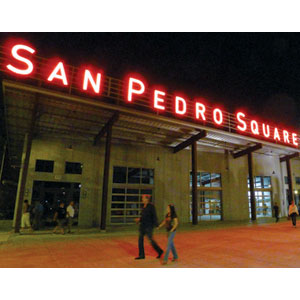Five storefronts and a parking lot along South First Street, from San Carlos to San Salvador, stand in dark contrast to their neighbors. The white lights and customers in occupied areas only accentuate what urban planners call “missing teeth” on this city block.
Downtown San Jose, like many cities trying to recover from the recession, has seen companies come and go, and restaurants and bars launch and leave. But one entity the city could always rely on to plow money into recruiting and subsidizing new businesses has all but turned out the lights as well. The San Jose Redevelopment Agency, which 10 years ago had 126 employees, has been reduced to a staff of just eight, mostly to process bond payments.
The agency has been thrown into limbo while municipalities sue the state of California over which branch of government should capture the economic benefits of urban revitalization. The lawsuit, filed by the California Redevelopment Association and the California League of Cities, comes in response to Gov. Jerry Brown’s redeployment of $1.7 billion in local redevelopment funds to balance the state budget. The California Supreme Court is expected to rule in January.
In the meantime, with no RDA involvement in propping up the economy in the core of America’s 10th-largest city, business leaders wonder what the future holds.
“Is the private sector ready to lead?” asks Scott Knies, executive director of the San Jose Downtown Association, who delivered an address to business and property owners last week at the Downtown Association’s annual meeting. Knies sees opportunity to be found in the RDA’s likely demise.
“My sense is really it’s going to be a mash-up of public sector, the city and a third sector—nonprofit leadership from us,” Knies says about the future.
And yet the impact felt by the impending elimination of one of the state’s most active agencies can’t be understated. Projects such as HP Pavilion, the Convention Center, the Fairmont Hotel and Tech Museum would not have come about without RDA investments.
San Jose’s signature summer event, Music in the Park, produced by the Downtown Association and sponsored by Metro, could be eliminated next year. The annual Christmas parade has already been canceled, ending the event’s nearly 40-year run.
“The parade is off. The city can’t afford it,” Knies says. “I don’t think that one has really hit home for people yet.”
The Downtown Association has been responsible for coordinating many of the city’s events that are free to the public, but that well could run dry soon. Redevelopment funding was 15 percent of the Downtown Association’s revenue last year, or about $650,000. This year, funding has been cut to $250,000.
“We got chopped pretty good,” Knies says. “We’re looking next fiscal year at potentially zero, because redevelopment might not even exist.”
If that happens, it will be anything but business as usual in San Jose.
Giving and Taking
When it comes to the impending extinction of redevelopment agencies, few business owners have feelings as complicated as Steve Borkenhagen.
Since co-founding the Camera One cinema in 1976, Borkenhagen has watched his own establishments—his family still owns Eulipia Restaurant on South First Street&—and others scratch and claw to remain relevant in the face of rising rents and publicly subsidized competitors.
The Redevelopment Agency, created in 1956, stimulated the economy by buying up underdeveloped and blighted land, but it also inflated property values. Meanwhile, owner-operated restaurants like Eulipia were forced to battle regional and national chains like Morton’s, Grill on the Alley, Il Fornaio and McCormick & Schmick’s, who moved into modern buildings funded or improved by the Redevelopment Agency after being recruited with the help of city officials.
“There was a time when the Redevelopment Agency was the only entity buying and selling properties, so it probably was creating a false market,” Borkenhagen says. “One thing I felt like it did was subsidize restaurants like McCormick & Schmick’s, when little guys like myself were trying to compete. It created a very unfair playing field.”
{pagebreak}
Borkenhagen’s current employer, the San Pedro Square Market, launched by former San Jose Mayor Tom McEnery, does not suffer from the same inequities. The market received $2.5 million in grants and a $2.5 million loan from RDA. An additional $1 million also will go to sidewalk and street improvements. But the difference in this newest venture and the RDA’s old habit of picking winners and losers, says Borkenhagen, who is charged with managing the market, is that it will serve as a local attraction and public benefit.
“The best agency projects would be infrastructure, sidewalks, street lighting, parks and the arena,” Borkenhagen says. “These are things that made the downtown a better place.”
The last chapter in the RDA’s history has yet to be written, and it could be an ambitious finish. The Diridon Development Authority, a shell organization established just before Gov. Brown’s move to abolish the state agencies, currently holds parcels valued at almost $25 million.
The City Council is considering a proposal to sell some of those parcels to Oakland A’s owner Lew Wolff to help solidify his bid for a proposed baseball stadium. If the team’s relocation is approved by Major League Baseball, and San Jose voters give their consent for city property to be leased for a stadium, the draw of a ballpark could make the Redevelopment Agency’s continuing existence seem superfluous in atrracting other businesses. Last year, 75 Silicon Valley CEOs and business leaders signed a letter to MLB Commissioner Bud Selig endorsing the A’s relocation to San Jose.
“A stadium would be a real shot in the arm to the city and its future,” says Richard Keit, the Redevelopment Agency’s executive director.
But with no other options for now, businesses, nonprofits and City Hall are being forced to form stronger bonds to encourage growth. The advocacy group 1stAct, which works to create a cultural identity for Silicon Valley through targeted events and streetscape improvements, is part of that plan.
The city’s Office of Economic Development (OED) recently formed a joint retention program with the Downtown Association, where a few members from both sides dedicate time to keep city office space filled. According to Kim Walesh, director of the OED, the program has pushed Oracle to move several hundred workers into its downtown office building while also attracting co-working community office spaces like NextSpace and TechShop.
“Sometimes when you have fewer staff and resources, it catalyzes an organization,” Walesh says. “It’s clear it’s time to write the next chapter in downtown—less dependence on government funding and more dependence on private leadership.”
But with cutbacks at all levels of government, staff’s ability to work at the “speed of business,” as Mayor Chuck Reed has called for, is easier said than done.
“How do you switch the mindset over there from regulator and tax collector, fee collector to enabler and partner?” Knies asks.
“It’s going to require people working together and partnerships and having a clear idea of where downtown is going,” Walesh says. “But business and property owners have a real opportunity to shape their environment.”

 Live Feed: Occupy Earth
Live Feed: Occupy Earth  Review: BN Chicken
Review: BN Chicken 

